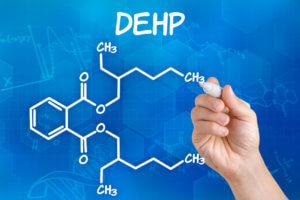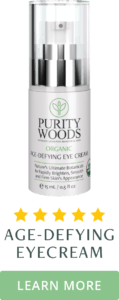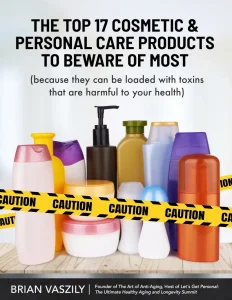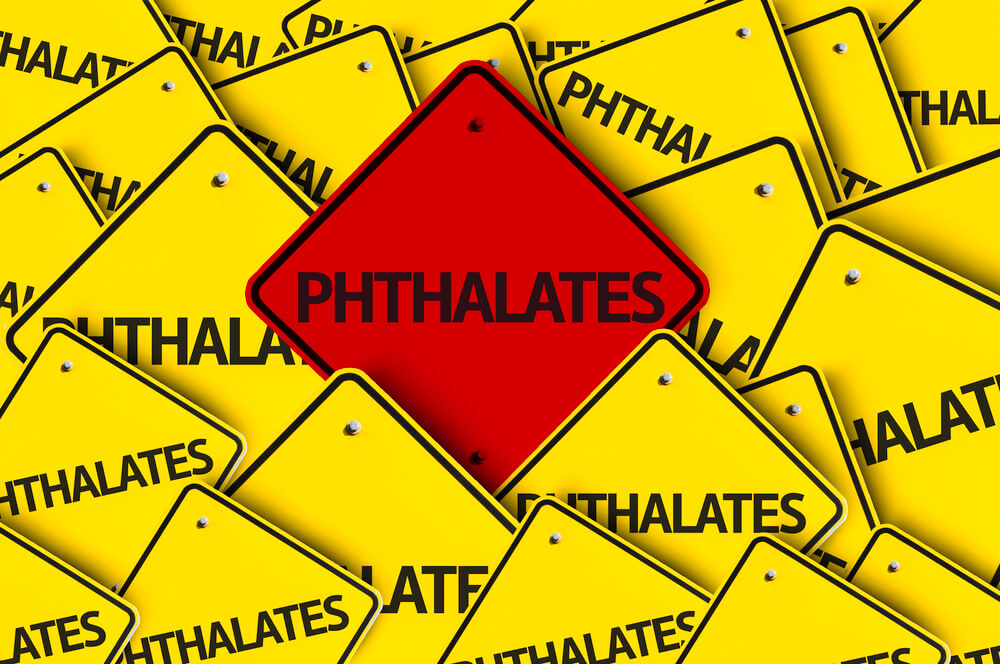Phthalates have been nicknamed “the everywhere chemical” because of how prevalent they have become in modern-day life. Not only are they found in thousands of everyday products, they have also made their way into the environment AND our bodies.
This is bad news because phthalates are linked to some serious health effects. And like so many other toxic chemicals, they are hiding out in places you would never expect, possibly entering your body on a daily basis.
Identifying and avoiding phthalate sources is (unfortunately) a complex issue, so here’s a look at everything you need to know about these ubiquitous chemicals, where they hide out, and the top phthalate dangers to your health.
What are Phthalates?
Phthalates are a group of chemical compounds that are widely used in consumer products. They were first introduced in the 1920s, picked up steam in the 1930s, and soon became incredibly popular with a variety of manufacturers.
If you want a little more on the chemical background, phthalates are made by adding a specific type of alcohol to phthalic anhydride in the presence of a catalyst, resulting in a colorless and odorless liquid. Obviously, this makes them synthetic chemicals and ones that unfortunately have toxic effects (more on that later).
You may hear phthalates referred to as “plasticizers” because one of their main functions is to make plastic more durable and flexible.
Another key characteristic of phthalates— and one that is very concerning for human health— is that they do not chemically bind to the material they are used in. This means they can easily leach into food, escape into the atmosphere, or be absorbed via mouth or skin contact.
Why Phthalates Are Used in Products

As mentioned, one of the main roles of phthalates is to add flexibility and durability to plastic.
To give you an example, they can be added to hard white plastic to make it into the pliable vinyl plastic you would see in shower curtains and IV tubing. In fact, phthalates largely became popular in the 1930s because they were the top choice for making polyvinyl chloride (PVC) flexible, giving it a much wider range of uses.
Given the “plastic-enhancing” nature of phthalates, you might expect to only find them in plastic products— but that’s not the case.
These chemicals also have properties that help fragrance ingredients to bind together and the scent to last longer. They even help topical products (lotions, creams, makeup, etc.) to stick better to the skin and absorb more easily, which has led to widespread use in personal care products.
Some phthalates help to dissolve certain materials and can be used in solvents as well.
The bottom line is that phthalate dangers are hard to avoid because this group of chemicals has multiple uses in numerous products. But the first step to avoiding them is determining where these chemicals are most likely to show up.
What Are Phthalates In? Top Sources
In 2008, it was determined that children and babies could ingest the most toxic forms of phthalates simply by chewing on one of their toys.
This led to a ban of three specific phthalates from being used in children’s toys and child care products at concentrations greater than 0.1% (still didn’t ban them entirely). In 2017, five more phthalates were added to the prohibited list for children’s toys and child care products.
In spite of this “progress”, phthalates are still present in thousands of everyday products that both children and adults regularly come in contact with. It’s impossible to list them all, but here are the top ones to be aware of.
Packaging

One of the most common places you’ll find phthalates is in plastic packaging. Ironically, this includes the packaging used for children’s toys as well as numerous other store-bought items.
Most alarming is the fact that phthalates are often used in plastic packaging for food products and bottled water. They are known to leach into all types of food, cooking oils, and beverages, which is why diet is thought to be the main route for human exposure to these chemicals.
Cosmetics and Personal Care Products
Another place you’re very likely to be exposed to phthalate dangers is in personal care products. Because these chemicals can help ingredients stick to each other and to your skin, they are widespread in products like lotions, creams, shampoo, deodorant, soaps, hair sprays, etc.
Phthalates are also commonly used in makeup products, especially nail polish, which often contains some of the most toxic chemicals.
Fragrance
Despite having no scent, phthalates are commonly used in fragrance products to help the scent last longer. This means they can be hiding in any product that contains fragrance: perfume, cologne, candles, air fresheners, scented skincare— the list goes on and on.
And because manufacturers are not required to reveal the specific ingredients they use to create their fragrance (under the loophole of “protecting trade secrets”), you will not see phthalates listed on the label. Your only clue that they may be present is the word “fragrance” or “parfum” on the product label.
Medication and Supplements
Here’s a disturbing fact: The very chemicals that are linked to a number of health problems are present in certain medications and supplements.
They are most likely to be found in enteric-coated pharmaceuticals where phthalates are used to help prevent the medication from dissolving before it reaches the intestines. However, they can also be present in drugs and supplements made with gel capsules and any kind of specialized release tablets.
Household Items (and Indoor Air)

Phthalates are used in a number of household fixtures, including vinyl flooring, carpeting, certain types of floor tiles, and any kind of vinyl or PVC building products. They may also show up in common items like shower curtains, garden hoses, cables and wires, vinyl upholstery, and plastic tablecloths (not to mention plastic food storage containers).
Unfortunately, phthalates are also one of the biggest indoor air pollutants because they easily release from the materials they are found in and contribute to “toxic dust”. This only adds to the existing phthalate dangers by increasing your likelihood of inhaling these toxic chemicals.
“Dining Out” Food
Research from George Washington University indicates that eating out at restaurants, fast food places, and cafeterias can increase your risk of phthalate exposure more so than cooking at home. Overall, those who ate out more frequently had phthalate levels nearly 37% higher than those who typically bought food from the grocery store to cook at home.
The researchers highlighted food typically held in phthalate-containing wrappers— like burgers and sandwiches— as the worst offenders but noted that any type of eating out was linked to higher phthalate levels.
They theorized that this was because food came in frequent contact with gloves, food processing equipment, and take-home boxes that are all likely to contain phthalates.
Phthalates in the Human Body
Unfortunately, the prevalence of phthalates in the world around us has directly translated to their presence in the human body.
Some earlier studies found that at least one type of phthalate was present in 99% of urine samples tested. Newer research indicates that this percentage has not changed and also notes that phthalate levels often exceed reference values set by the EPA and the European Food Safety Authority.
How to Find Phthalates on the Label
It’s challenging to completely avoid phthalate dangers because these chemicals are everywhere. But one important step you can take is to avoid them in personal care products, cosmetics, and even supplements by regularly reading labels.
This isn’t easy to do because there are many different variations of phthalates. To help you out, here’s a list of the eight most widely used versions with their full names and abbreviations:
- Dibutyl phthalate (DBP)
- Diethyl phthalate (DEP)
- Di-(2-ethylhexyl) phthalate (DEHP)
- Butyl benzyl phthalate (BBP)
- Diisononyl phthalate (DiNP)
- Diisodecyl phthalate (DiDP)
- Di-n-hexyl phthalate (DnHP)
- Di-n-octyl phthalate (DnOP)
- BONUS: Fragrance— may contain phthalates not listed on the label
In short, along with avoiding products that specifically have the word “phthalate” on the label, be suspicious of ingredient abbreviations that end in “P”, and avoid fragrance like the plague!
And if you’re wondering why you want to avoid phthalates as much as humanly possible…
Why Are Phthalates Bad? Top Phthalate Dangers
Endocrine Disruption

Endocrine disruptors are chemicals that mimic, repress, or otherwise interfere with hormones. They essentially disrupt the endocrine system, which is the system that produces hormones and regulates hormone receptors throughout your body.
Phthalates have long been suspected endocrine disruptors, and the European commission has now determined that there is “sufficient evidence” that BBP, DEHP, and DBP lead to endocrine disruption in living organisms. DiDP and DiNP are listed as having the potential to cause endocrine disruption.
The exact hormonal effects of phthalates are still being determined. However, they have already been linked to altered hormone levels in baby boys (exposed to phthalates via breast milk) and feminization of male prenatal genital development.
Reproductive and Developmental Effects
Some research has found that phthalate metabolites are associated with increased DNA damage in male sperm. In addition, decreased sperm quality and male infertility are associated with metabolites of DEP and DEHP. Higher levels of these specific phthalates may even strongly impair sperm motility.
In the female body, phthalates have been implicated in fertility disorders and may reduce the levels of certain sex hormones.
Of particular concern is the fact that phthalate exposure during pregnancy can negatively affect the fetus and potentially increase the risk of a preterm birth. Phthalates can also be passed on to a child through breastmilk and are linked to impaired brain development and a greater risk of allergic and behavioral disorders.
Cancer
Emerging research is revealing that increased cancer risk should be on the list of possible phthalate dangers.
While nothing is “conclusively proven” yet, the Environmental Protection Agency (EPA) and National Toxicology Program list DEHP as reasonably anticipated to be a human carcinogen. This is partly based on evidence that DEHP can cause liver tumors in animals and may do the same in humans.
Some very recent studies have shown even more cancer-causing potential from phthalates, including one that links childhood phthalate exposure to increased cancer risk. Specifically, exposure to phthalates prenatally or via medicine was associated with a greater incidence of osteosarcoma and lymphoma before the age of 19.
On top of this, certain phthalates (particularly DEP) may also be associated with increased breast cancer risk. Some lab studies have even shown that low concentrations of phthalates can induce proliferation in human breast cancer cells.
Early Death and Heart Disease

An astonishing study came out in 2022 linking phthalates to a greater risk of dying from heart disease or any cause. The study included over 5000 adults and compared phthalate levels in urine samples with mortality data.
The results were quite shocking: Those who had higher levels of phthalate metabolites (particularly metabolites of DEHP) in their urine had consistently higher rates of cardiovascular and all-cause mortality. The researchers also identified a potential loss of $39.9–47.1 billion in economic productivity due to premature deaths.
While the authors of the study do call for further studies to “corroborate observations and identify mechanisms”, they also state that regulatory action is “urgently needed” where phthalates are concerned.
Needless to say, this study is a serious incentive to avoid phthalates as much as you can.
Best Ways to Avoid Phthalate Exposure
As you’ve probably realized by now, it’s impossible to avoid phthalate dangers completely, but there is much you can do to limit your exposure. The list of “best practices” includes the following:
- Only use phthalate-free cosmetics, skincare, and personal care products. Look for products that are clearly labeled as “phthalate-free” and/or scrutinize the label for phthalate ingredients and their abbreviations. (See the list of common variations above.)
- Avoid fragrance. This is worth saying again. Do not use anything in your home or on your body that contains synthetic fragrance. These products may contain phthalates as well as numerous other fragrance toxins.
- Ditch vinyl. Vinyl products (shower curtains, flooring, blinds) almost always contain phthalates, so replace them with less toxic alternatives when possible. Some companies do make phthalate-free vinyl flooring as an option now.
- Ditch food and beverages in plastic. Phthalates in plastic easily leach into food and drinks, especially when the plastic is heated. Opt for glass food storage containers instead, and consider getting a glass or stainless steel water bottle rather than drinking from a plastic one.
- Cook at home more often. Since eating out is linked to increased phthalate exposure, try cooking at home more often if you normally dine out regularly. Buy unpackaged ingredients as much as possible, and don’t store produce in plastic bags.
Phthalate-Free Skincare for Younger-Looking Eyes

Obviously, you don’t want to apply phthalates to any part of your skin because of their toxic effects. However, the skin around your eyes is an especially sensitive and vulnerable area that can really be wrecked by harmful chemicals.
If you are in the market for 100% phthalate- and toxin-free skincare products, look into the Age-Defying Eye Cream from Purity Woods.
This carefully formulated eye cream is made with 20+ botanical ingredients that deeply moisturize the skin around your eyes while also erasing the appearance of fine lines, crow’s feet, under-eye bags, etc. The entire formula is USDA Certified Organic, which means absolutely ZERO phthalates, parabens, preservatives, or any other synthetic chemicals.
Learn more about the Age-Defying Eye Cream right here, and be sure you become intentional about eliminating phthalates from your life to avoid their health dangers.



Such important information for everyone….thank you
Thank you so much for this info. I had no idea this chemical existed. I bet there’s a lot more out there I don’t know about. Now you mentioned that this chemical is everywhere so it’s in the air, in our food, in our cosmetics etc. So we absorb them, inhale them, and digest them? Now we know that they get into us. My question is How do we get them OUT of us.? They don’t wash off right? Can we eat something that absorbs them from our bodies? Perhaps an air purifier that can minimize the amount in our homes? Do you suggest storing our foods in glass containers only? Thank you.
The bottom of the feet have 1000’s of pores…Platinum Energy Systems (based in Canada) has a foot bath detox device that magnetically pulls out toxins and heavy metals from the body. This is a medical device and the best one in the world for this. Also, zeolite is a mineral found in nature that attracts heavy metals and toxins from the environment. A company called Waiora has a zeolite product that has purified the zeolite, crushed it and mixed it with water. You simply use 10 drops/day (or more often if you wish…it is harmless), and because of the opposite electron charge, it attracts the toxins/heavy metals in your body and is excreted through the urine. Totally safe and harmless!
All plastics leach so glass is best. There are phylates everywhere and even in our clothes as PVC from “recycled’ plastics like at the reknown and supposed environmentally “concerned” Patagonia. Cook only in stainless or ceramic or iron and store in glass containers. But we cannot escape the torrent of toxic chemicals that are being dumped on us from all angles, even the chem trails in the sky are fully of heavy metals and graphine oxide etc.
Even fluoride in our water and toothpaste as well.
I have been using fluoride-free toothpaste for many years & only drink filtered water
Much appreciated, thank you for the information. It is so educational.
I’m going to look through all my cosmetics right now, and get rid of my plastic shower curtain thankyou for such informative advice.
Thank you so much for this information. I
will not be using plastic bags. Also I
will check any perfumes and makeup..
Most excellent research and advice!
I so much appreciate your work and “my” (smile) and thereby my family’s support!
Thank you so much for this information. I just bought a house with lots of vinyl plank flooring and I do believe it is giving me a headache and throat and nasal irritation. I may have to sell the house already as I believe the floor has been in place long enough that it should not be off-gassing and the floor is one thing my cats and I cannot escape from !
Thank you for making a complex subject easier to understand.
For sometime I have been adverse to the damaging effects of plastic but were unable to explain this clearly. Now I understand.
I’ve used a glass drinking bottle of over 10 years now and since reading your article will scrutinise my environment for other areas I can eliminate.
What role does phatalates play in micro plastics?
I will share this article far and wide!
good job on this
Excellent article. We have to avoid toxins where we can in this toxic world. Good to know what the abbreviations mean on the label, which ones mean “phthalates”. READ the LABEL!! It is unbelievable how much phthalates have invaded our world.
Thank you Brian.
A helpful and revealing article. I have been wondering how to find out about plastic storage jars only recently, and whether manufacturers (UK or US) had found alternative ways to avoid using phthalates in their most recent plastic products!?! Your article answers many of my questions and suggests that it is always sensible to avoid plastics especially when it comes to food and drink and children’s toys.
Thank you.
thanks for the work you invested in sharing this important information 👍
Thank you for this informative and well-written article! Very clear and comprehensive!
As always, thank you so much for all your information and research. I have a notebook filled with all my notes!
It’s so sad that Crooked Politicians and Greedy Corporations are allowing our Country to be Poisoned by these and Many other Toxins. EPA and USDA are doing a Rotten Job of Protecting us from the Dangerous Chemicals in most of the Products we use. Our government is terribly Broken and has abrogated most of the Responsibility for keeping us Safe and Secure.
I absolutely agree with you whole-halfheartedly and I wish this article would change things!
I absolutely agree! How can they just sit back, knowing all these toxins and hazards are ruining our health and our planet?
Amen to that!!
Hugely appreciated, thank you for all the information.
I now understand a great deal more, as you explained it all so simply end in such depth. Thank you
Scary! It would be helpful to know if there is an effective way to detox phthalates.
Thank you for this vital information.Even though we may be going to great lengths to adopt healthy lifestyles etc, it takes just a small amount of these nasty chemicals to spoil it all..At least we can try to be more alert and aware to eliminate them as much as possible from our lives, all thanks to your efforts and articles such as these. Much appreciated!
I understand that Americans die younger than do many in other countries… the amount of plastic used in this country may be one reason why!
I’ve been buying bottled spring water in plastic bottles because I hate the taste of my city’s water (which I would never drink straight anyway except that one taste…) and if I just got a filter for my kitchen sink, it might be free of contaminants, but it would still taste icky. I’m renting so I can’t get a whole house system. Any ideas of a better solution for drinking water? Thanks!
I have been using the Berkey Filtering System for many years and it has been continuously rated as an excellent Filtering System. I am using that filtered water for any consumption, for drinking or cooking, even for my cat’s consumption.
Yes, love water from that filter system. It does have some small plastic parts itself but mostly is made from stainless steel and ceramic.
I have been using the AquaTru water system from Canada for 7 years now. Its a Reverse Osmosis system that I then put minerals in to re-balance. They have machines that automatically add the minerals after, too. it is CLEAN, PURE, WATER! The Phoenix, AZ city water is atrocious and I NEVER drink it! The AquaTru replacement filers are very economical. I used to use a Berkey filter system, but the AquaTru is far better and cheaper to use. The Berkey systems are gravity drip/no electricity, while the AquaTru uses electricity. I refill empty GLASS 16 oz bottles to take with me when I leave the house. I bought probiotic drinks in glass bottles and have been reusing them since for my water.
Can anyone tell me the name of a healthy makeup line? In particular, I’m looking for a foundation (that doesn’t look like “zinc face”, but rather has a tan tint? Also, I’m looking for safe, matte eyeshadows in browns & neutral colors. If anyone can help, I’d be very grateful. Thank you!
Purity Woods is the cleanest and best organic makeup I have ever used. I have been using it for years.
This is a real wake up call! We really are dancing on an edge here. You have made it clear that every decision is so important. The sooner phthalates are restricted, or banned, the better. Hopefully the more recent swaps from plastic to recyclables due to the environmental issues, will reduce phthalates in our environment. There must be so much in the sea and water ways too. Does it break down safely over time, or create something just as noxious, I wonder?
An excellent and clearly written article about a very complex and important issue. I will share this one with many of my friends. I have already implemented a big number of the suggestions for a couple of years, but there is a lot more work to be done for me!
I am wondering if there are any studies or research suggesting that the pvc piping used in pretty much all new construction for a long time now (including pex) leaches plastic into all our household water? Could be an rationale for making sure to keep copper piping in a home.?
I wondered the same thing as I read the article. We have changed to copper piping whenever we’ve had to replace pipe. So hard to get away from plastics. And poor babies, getting it from every angle.
This was very helpful from a descriptive definition to listing the names of phthalates to recognize. While not a conclusive list, it does give a place to start. What was once thought very helpful has now turned to potential death. Thank you for helping us learn what’s good.
Interesting that even thought the powers that be know this stuff, they still allow it to continue.
Great article about how to avoid toxins like phtalates. But to measure the amount of these phtalates in the urine, what urine test I specically do I need for?
These phtalates are so insidious! They should be outlawed!
…wished all plastic was banned from food !! have been avoiding all plastic in my kitchen for YEARS !! Very hard to avoid plastic, vinyl in building materials !! thank you for all the information !!
Thank you, more things to look out for. Very good article.
What about clothing recyled with plasitics. They must be full of them.
Hi Scarlett, please see https://theartofantiaging.com/toxic-clothing-common-health-hazardous-fabrics-and-what-to-choose-instead/